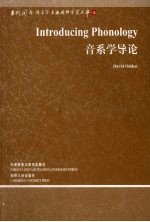

音系学导论PDF电子书下载
- 电子书积分:12 积分如何计算积分?
- 作 者:(美)奥登著
- 出 版 社:北京:外语教学与研究出版社
- 出版年份:2008
- ISBN:9787560079578
- 页数:348 页
1 What is phonology? 1
1.1 Concerns of phonology 2
1.2 Phonetics-what is physical sound? 4
1.3 The symbolic representation of speech 14
Summary 16
Exercises 17
Notes to this chapter 17
Suggestions for further reading 17
2 Phonetic transcriptions 19
2.1 Vowels:their symbols and properties 20
2.2 Consonants:their symbols and properties 26
2.3 IPA symbols 34
2.4 Illustrations with English transcription 36
Summary 37
Exercises 40
Notes to this chapter 42
Suggestions for further reading 42
3 Allophonic relations 43
3.1 English consonantal allophones 44
3.2 Allophony in other languages 49
Summary 61
Exercises 61
Notes to this chapter 66
Suggestions for further reading 66
4 Underlying representations 67
4.1 The importance of correct underlying forms 68
4.2 Refining the concept of underlying form 71
4.3 Finding the underlying form 73
4.4 Practice at problem solving 80
4.5 Underlying forms and sentence-level phonology 82
4.6 Underlying forms and multiple columns in the paradigm 85
Summary 94
Exercises 94
Notes to thischapter 98
Suggestions for further reading 98
5 Interacting processes 99
5.1 Separating the effects of different rules 100
5.2 Different effects of rule ordering 112
Summary 121
Exercises 122
Notes to this chapter 128
Suggestions for further reading 128
6 Feature theory 129
6.1 Scientific questions about speech sounds 130
6.2 Distinctive feature theory 135
6.3 Features and classes of segments 150
6.4 Possible phonemes and rules-an answer 154
6.5 The formulation of phonological rules 157
6.6 Changing the theory 160
Summary 166
Exercises 167
Notes to this chapter 168
Suggestions for further reading 168
7 Doing an analysis 169
7.1 Yawelmani 170
7.2 Hehe 177
7.3 Icelandic 185
7.4 Modern Hebrew 191
7.5 Japanese 197
Summary 207
Exercises 207
Notes to this chapter 224
Suggestions for further reading 224
8 Phonological typology and naturalness 225
8.1 Inventories 226
8.2 Segmental processes 228
8.3 Prosodically based processes 244
8.4 Why do things happen? 250
Summary 255
Notes to this chapter 256
Suggestions for further reading 256
9 Abstractness and psychological reality 257
9.1 Why limit abstractness? 258
9.2 Independent evidence:historical restructuring 273
9.3 Well-motivated abstractness 277
9.4 Grammar-external evidence for abstractness 287
9.5 How abstract is phonology? 297
Exercises 298
Notes to this chapter 300
Suggestions for further reading 300
10 Nonlinear representations 301
10.1 The autosegmental theory of tone:the beginnings of change 302
10.2 Extension to the segmental domain 321
Summary 329
Exercises 329
Notes to this chapter 331
Suggestions for further reading 331
Glossary 333
References 339
Index of languages 345
General Index 347
- 《物联网导论》张翼英主编 2020
- 《材料导论》张会主编 2019
- 《化工传递过程导论 第2版》阎建民,刘辉 2020
- 《大数据导论》林子雨编著 2020
- 《跨文化交际学基础导论》林大津,尤泽顺导读 2007
- 《现代环境主义导论》(英)戴维·佩珀(David Pepper)著 2020
- 《现代食品系统工程学导论》于秋生主编 2019
- 《生物多样性导论》王慷林,李莲芳编著 2019
- 《数据科学导论》吴喜之主编 2019
- 《大数据导论 大数据思维与创新应用》何明 2019
